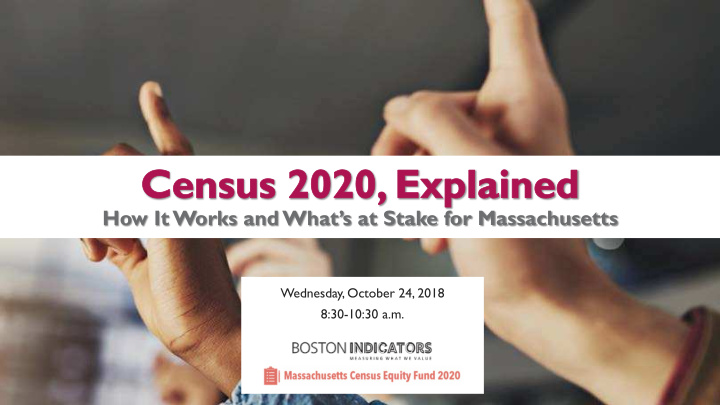



How It Works and What’s at Stake for Massachusetts Wednesday, October 24, 2018 8:30-10:30 a.m.
The Original 1790 Census 1. Name of the head of the family 2. # of free white males16 y.o.+ 3. # of free white males <16 y.o. 4. # of free white females 5. # of all other free persons 6. # of slaves
Planned Questions for 2020 Census
Planned Questions for 2020 Census
The current race/ethnicity questions doesn’t always reflect how people identify. Source: “The Americans Our Government Won’t Count,” Alex Wagner, NYT, 3/30/18
Alternative 2020 Approach Approach (not adopted)
Formalized collection of same-sex household information
The annual American Community Survey (ACS) continues to supplement the decennial Census, gathering much more detailed socio-economic data. Examples: • Type of housing (e.g. single family, apartment, mobile home) • Computer ownership (e.g. desktop, laptop, smartphone, tablet) • Educational attainment • Health insurance coverage • Country of birth • Employment • Income • Mode of transportation to work
One quarter of all tracts in Massachusetts are hard to count. HTC tracts (Census tracts with return rates less than 73%). Massachusetts Lawrence Lowell Worcester Chicopee Springfield Brockton Orleans Fall River New Bedford
People who are less likely to return their Census forms include those who: 1. Rent or move frequently 2. Live in group quarters 3. Live in non-family households (with unrelated friends or roommates) 4. Distrust the government 5. Speak a less common language 6. Have lower incomes or lower educational attainment 7. Live in homes with non-standard addresses, like accessory dwelling units or very rural homes
Nearly 415,000 Bostonians live in hard to count tracts. Source: Census Planning Database, 2012-2016. American Community Survey 5-Year, 2012-2016.
More Bostonians live in hard to count tracts than do residents of similar cities. Percent of population living in HTC tracts, among similar cities in 2014 63% 58% 54% 31% 26% 20% 12% 7% Boston New York City Philadelphia City of Miami Baltimore Washington, DC San Francisco Seattle Source: Census Planning Database, 2012-2016. American Community Survey 5-Yr Sample, 2012-2016
Boston’s rental and group quarters populations make up 2/3rds of the city, the second most of similar cities. Percent of population living in rental housing and group quarters (inclusive of non-family rental housing populations), 2016 Miami 66% 69% Boston 59% 66% New York City 64% 66% Washington, DC 55% 61% San Francisco 55% 57% Baltimore 51% 54% Seattle 47% 50% Philadelphia 44% 48% Renters People Living in Group Quarters Source: American Community Survey, 2016
Boston has large low-income and foreign born populations, comparable with those in similar cities. % foreign born % living below 200% of poverty 58% 53% 47% 37% 41% 35% 38% 36% 29% 30% 22% 22% 19% 15% 13% 8% Source: American Community Survey, 2016
Census-Guided Health Care Funding
Census-Guided Housing and Transportation Funding
Census-Guided Food and Nutrition Funding
Census-Guided Social Services Funding
Census-Guided Education Funding
Likely addition of a citizenship question • Citizenship question has not gone through the standard testing and vetting process. • Experts worry that this question will depress the count, particularly among non-citizens. • The citizenship question is being challenged in court.
2020 will be the first online Census. Prior approach: 2020 web-centric approach: 1. Questionnaire mailed to 1. Simple mailers sent to every every household household with instructions on how to complete online questionnaire 2. Household completes and mails back 2. Household completes it online 3. If no response from 3. If no response from household, paper household, Census workers questionnaire will be mailed followed-up in person or on 4. If still no response, Census workers phone to encourage follow-up in person or on phone to response encourage response
Privacy and the Census • Census Bureau pledges that it “will never share a respondent’s personal information with immigration enforcement agencies, like ICE; law enforcement agencies, like the FBI or police; or allow it to be used to determine their eligibility for government benefits.” • Ultimate success will depend on Census Bureau’s ability to convince the public that this information will indeed be protected from misuse.
Census Bureau funding for 2018 was far less than at this point in previous decennial Census cycles. Change in Census Bureau budget relative to year 6 of each decade 150% Census 2000 Census 1990 100% Census 2010 50% Census 2020 0% Year 6 Year 7 Year 8 Note: All years are fiscal years. Figures show discretionary budget authority in each year of the decade relative to that in the sixth year Source: Center on Budget and Policy Priorities
Mail response rate Cost of reaching a single $107 housing unit, inf. adj. 100% $100 As mail response $92 rates have decreased, 90% $80 the cost of reaching $80 every household in 78% 80% the United States $60 has increased. $45 70% $40 $34 63% 60% $16 $20 $- 50% 1970 1980 1990 2000 2010 2020 (est.) Source: 1970-2010 data from U.S. Government Accountability Office report “2020 Census: Continued Management Attention Needed to Mitigate Key Risks Jeopardizing a Cost-Effective and Secure Enumeration”. 2020 data from Census Bureau’s “2020 Census Life-Cycle Cost Estimate Executive Summary”
Thank you! www.bostonindicators.org
Recommend
More recommend